NVIDIA GeForce GTX 670 Review Feat. EVGA: Bringing GK104 Down To $400
by Ryan Smith on May 10, 2012 9:00 AM ESTCompute
Shifting gears, as always our final set of benchmarks is a look at compute performance. As we have seen with GTX 680, GK104 appears to be significantly less balanced between rendering and compute performance than GF110 or GF114 were, and as a result compute performance suffers. Cache and register file pressure in particular seem to give GK104 grief, which means that GK104 can still do well in certain scenarios, but falls well short in others.
Our first compute benchmark comes from Civilization V, which uses DirectCompute to decompress textures on the fly. Civ V includes a sub-benchmark that exclusively tests the speed of their texture decompression algorithm by repeatedly decompressing the textures required for one of the game’s leader scenes. Note that this is a DX11 DirectCompute benchmark.
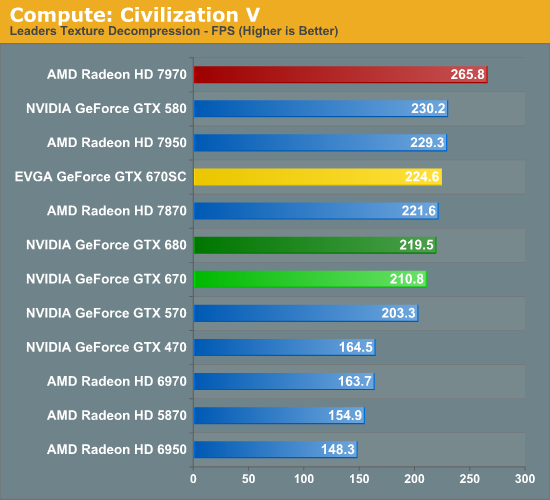
It’s quite shocking to see the GTX 670 do so well here. For sure it’s struggling relative to the Radeon HD 7900 series and the GTX 500 series, but compared to the GTX 680 it’s only trailing by 4%. This is a test that should cause the gap between the two cards to open up due to the lack of shader performance, but clearly that this not the case. Perhaps we’ve been underestimating the memory bandwidth needs of this test? If that’s the case, given AMD’s significant memory bandwidth advantage it certainly helps to cement the 7970’s lead.
Our next benchmark is SmallLuxGPU, the GPU ray tracing branch of the open source LuxRender renderer. We’re now using a development build from the version 2.0 branch, and we’ve moved on to a more complex scene that hopefully will provide a greater challenge to our GPUs.
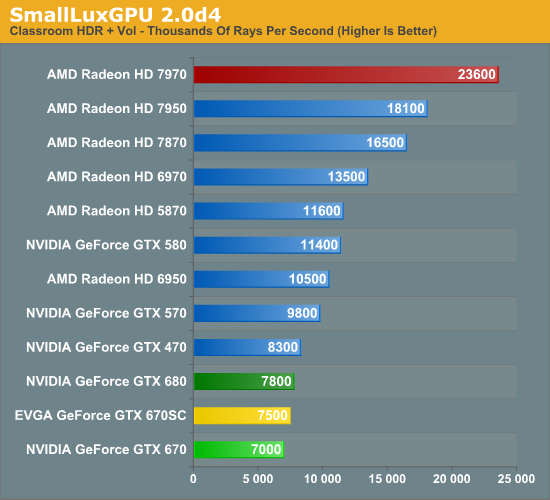
SmallLuxGPU on the other hand finally shows us that larger gap we’ve been expecting between the GTX 670 and GTX 680. The GTX 680’s larger number of SMXes and higher clockspeed cause the GTX 670 to fall behind by 10%, performing worse than the GTX 570 or even the GTX 470. More so than any other test, this is the test that drives home the point that GK104 isn’t a strong compute GPU while AMD offers nothing short of incredible compute performance.
For our next benchmark we’re looking at AESEncryptDecrypt, an OpenCL AES encryption routine that AES encrypts/decrypts an 8K x 8K pixel square image file. The results of this benchmark are the average time to encrypt the image over a number of iterations of the AES cypher.
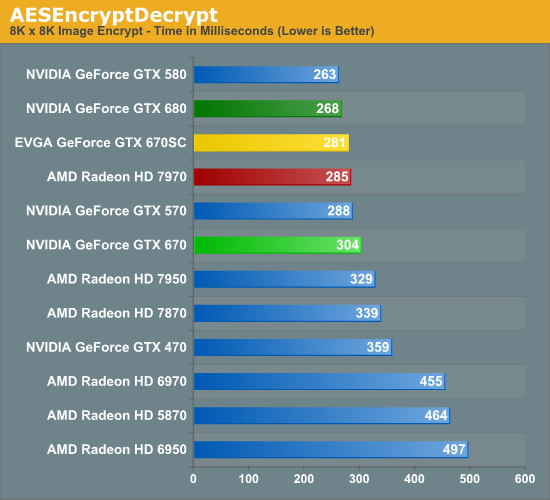
Once again the GTX 670 has a weak showing here, although not as bad as with SmallLuxGPU. Still, it’s enough to fall behind the GTX 570; but at least it’s enough to beat the 7950. Clockspeeds help as showcased by the EVGA GTX 670SC but nothing really makes up for the missing SMX.
Our foruth benchmark is once again looking at compute shader performance, this time through the Fluid simulation sample in the DirectX SDK. This program simulates the motion and interactions of a 16k particle fluid using a compute shader, with a choice of several different algorithms. In this case we’re using an (O)n^2 nearest neighbor method that is optimized by using shared memory to cache data.
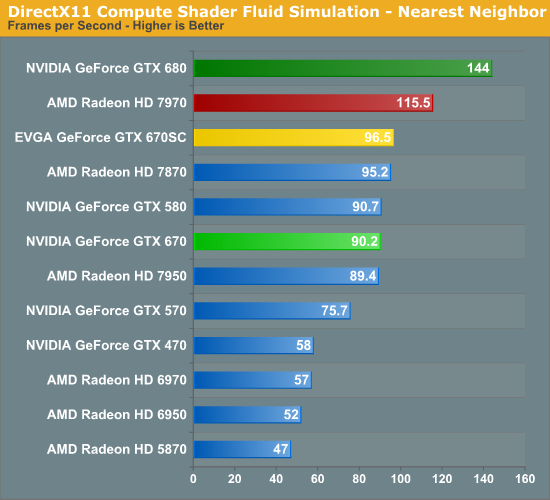
For reasons we’ve yet to determine, this benchmark strongly dislikes GTX 670 in particular. There doesn’t seem to be a performance regression in NVIDIA’s drivers, and there’s not an incredible gap due to TDP, it just struggles on the GTX 670. As a result performance of the GTC 670 only hits 42% of the GTX 680, which is well below what the GTX 670 should theoretically be getting. Barring some kind of esoteric reaction between this program and the unbalanced GPC a driver issue is still the most likely culprit, but it looks to only affect the GTX 670.
Finally, we’re adding one last benchmark to our compute run. NVIDIA and the Folding@Home group have sent over a benchmarkable version of the client with preliminary optimizations for GK104. Folding@Home and similar initiatives are still one of the most popular consumer compute workloads, so it’s something NVIDIA wants their GPUs to do well at.
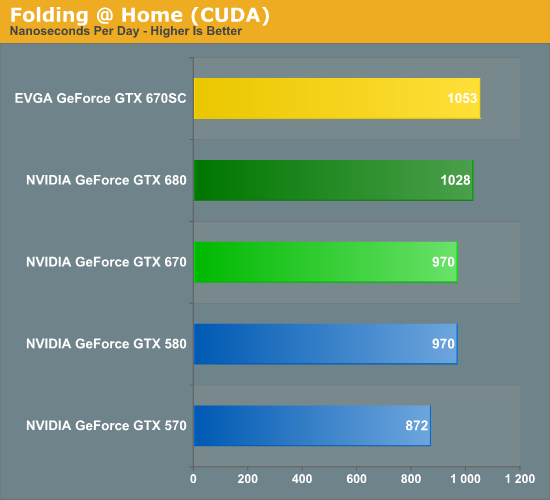
Whenever NVIDIA sends over a benchmark you can expect they have good reason to, and this is certainly the case for Folding@Home. GK104 is still a slouch given its resources compared to GF110, but at least it can surpass the GTX 580. At 970 nanoseconds per day the GTX 670 can tie the GTX 580, while the GTX 680 can pull ahead by 6%. Interestingly this benchmark appears to be far more constrained by clockspeed than the number of shaders, as the EVGA GTX 670SC outperforms the GTX 680 thanks to its 1188MHz boost clock, which it manages to stick to the entire time.










414 Comments
View All Comments
Spunjji - Friday, May 11, 2012 - link
Sick burn ;DyankeeDDL - Thursday, May 10, 2012 - link
Why would AMD fans be sad?AMD enjoyed a multi-months lead in performance, over-charging for their cards that had, substantially, no competitions at their price levels.
Now NVIDIA made a move, and it's a very good one: AMD will need to drop the prices and I see really no reason why they couldn't, as they have just a marginally larger die size (300mm2 vs 365mm2) on the same fab/technology.
Price drop is always a win for the customers, be that an Nvidia or an AMD fanboy (or just an enthusiast).
MrSpadge - Thursday, May 10, 2012 - link
That's right. With some more pressure and HD7950 at 300€ GCN may actually start to become a real option! Saying this as a Cayman owning AMD-preferer.andrewaggb - Thursday, May 10, 2012 - link
It's not like the 7970 is a bad card, it's somewhat slower at games, has more ram, is much faster at gpu compute, and is still a relatively low power offering.There's always something better just around the corner. Buy what's best when you need it, and be happy about it :-). Give it 6 months to a year and there will be something better than the 670 as well.
CeriseCogburn - Friday, May 11, 2012 - link
If the 7970 is much faster at gpu compute, why did it lose 3 of 5 compute benchmarks in this review ?Hmm... loser but better, loser but better...
Also amd power loser but "still relatively a low power offering", loser but relatively a winner, loses but it's a winner anyway...
I've got it ! The loser is better and wins !
SlyNine - Saturday, May 12, 2012 - link
Seriously dude. I MIGHT could give you the first point, if it wasn't riddled full of biased.But the second point doesn't even make sense.
"Also amd power loser but "still relatively a low power offering", loser but relatively a winner, loses but it's a winner anyway..."
Now you're just throwing words in his mouth he didn't even use. What a fail!
GTX680 owner speaking.
CeriseCogburn - Sunday, May 13, 2012 - link
" and is still a relatively low power offering." (his words I responded to)Okay, maybe I went overboard.
On the other hand, we haven't heard this going the other way at all, and the 7970's loss in the power envelope is loss of a reason to buy an amd card.
Relatively, it's a high power offering, we are after all comparing the two brands, and it's high power usage allows the claims for victory in compute (even when the software base does not).
Galidou - Sunday, May 13, 2012 - link
''Okay, maybe I went overboard.''You do that all day long going overboard...
CeriseCogburn - Sunday, May 13, 2012 - link
You do nothing but lie and attack, so you have zero room to talk.Galidou - Monday, May 14, 2012 - link
And I am the one who attack, I attack but not you? LOL you're so fun, don'T make me copy and paste every word lack of respect the abuse of words such as massive ignorance, stupid, everyone lies but not you... and everyone lacks of respect but not you... OMG that's extreme